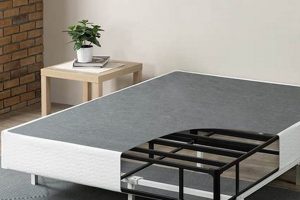The dimensions of a sleeping surface designed for a daybed are crucial to both comfort and functionality. These mattresses typically deviate from standard bed sizes, requiring careful consideration to ensure a proper fit within the daybed frame. Measurements may correspond to a twin or slightly larger, tailored to accommodate the unique design of these versatile furniture pieces. As an example, a standard twin mattress measures approximately 38 inches wide and 75 inches long, a common dimension for daybed applications.
Properly sized sleeping surfaces are essential for maximizing the usability and aesthetic appeal of a daybed. Selecting the correct dimensions prevents overhang or gaps, ensuring a comfortable sleeping or lounging experience. Historically, daybeds have served dual purposes, functioning as seating during the day and a sleeping space at night, thus demanding a mattress that balances support and visual integration within the room’s decor. The right choice enhances both the practicality and style of the furniture.
Therefore, understanding the specific dimensions required for a daybed mattress is paramount. The following sections will delve into various aspects, including common size specifications, material considerations, and factors influencing the selection process, thereby providing a complete overview for informed decision-making.
Essential Considerations for Daybed Mattress Dimensions
Selecting the appropriately sized mattress for a daybed is crucial for both comfort and aesthetic integration within a living space. The following guidelines offer practical advice for ensuring optimal selection and use.
Tip 1: Measure the Daybed Frame Interior. Accurately measure the interior dimensions of the daybed frame before purchasing a mattress. This measurement serves as the primary guide to avoid overhang or undesirable gaps.
Tip 2: Consult Manufacturer Specifications. Refer to the daybed manufacturer’s specifications for recommended mattress dimensions. These guidelines typically offer precise measurements optimized for their specific frame design.
Tip 3: Prioritize Snug Fit. Aim for a snug fit, allowing minimal space between the mattress and the frame. Excessive gaps can compromise comfort and stability, potentially leading to premature wear.
Tip 4: Consider Mattress Thickness. Evaluate the desired mattress thickness in relation to the daybed’s design. Thicker mattresses may obstruct access to storage compartments or alter the overall aesthetic appearance.
Tip 5: Evaluate Weight Capacity. Confirm the daybed’s weight capacity and select a mattress that remains within those limits. Exceeding the weight limit can damage the frame and compromise the structural integrity.
Tip 6: Test for Comfort. If possible, physically test the mattress on a similar daybed frame to assess comfort levels. This allows for evaluation of firmness, support, and overall suitability.
Adherence to these guidelines promotes longevity, maximizes comfort, and ensures the selected sleeping surface complements the daybed’s design, increasing its overall utility.
The subsequent sections will explore material selection and other critical factors for informed decision-making.
1. Twin dimensions
Twin dimensions constitute a prevalent standard within the realm of mattress selection for daybeds. The correspondence between specified mattress dimensions and the daybed frame’s internal measurements is critical for functionality and aesthetics. A mattress that deviates significantly from the intended twin size, typically 39 inches wide and 75 inches long, may result in overhang, instability, or an improper fit. For instance, a mattress exceeding these dimensions could impair the daybed’s ability to function as a seating area, while one undersized could lead to discomfort and compromised structural support.
The application of twin-sized mattresses in daybeds serves various practical purposes. The dimensions allow for a comfortable single sleeping surface while simultaneously maintaining a compact footprint suitable for multi-functional spaces. In guest rooms or home offices, daybeds utilizing twin-sized mattresses offer a convenient solution for accommodating overnight visitors without requiring dedicated bedroom space. Further, the availability of twin-sized bedding and accessories simplifies the process of outfitting the daybed for either sleeping or lounging purposes. Mismatched or incorrect mattress dimensions detract from the overall utility and visual harmony.
In summary, a thorough comprehension of twin dimensions is indispensable when selecting a mattress for a daybed. Precise measurements and adherence to manufacturer specifications guarantee optimal fit and functionality. Challenges may arise from variations in frame design; thus, careful assessment and verification are crucial. This understanding directly contributes to the long-term usability and aesthetic appeal of the daybed, ensuring it effectively serves its intended purpose within the designated environment.
2. Thickness variations
Thickness variations in daybed mattresses directly impact the overall comfort, aesthetics, and functionality of the furniture piece. The selected depth influences the sitting height, ease of entry and exit, and the visual proportion relative to the daybed frame. A mattress that is too thick may overwhelm the frame, obstructing decorative elements or making it difficult to sit comfortably. Conversely, an overly thin mattress might provide insufficient support, resulting in discomfort during sleep or prolonged lounging. An appropriate example involves a daybed with a trundle; the mattress thickness must accommodate the trundle’s storage space beneath the frame. Manufacturers specify maximum mattress depths to prevent operational impediment.
Practical applications of understanding thickness variations extend to optimizing the daybed’s versatility. In multi-purpose rooms, a thinner, firmer mattress could serve dual functions: offering adequate support for sleeping while allowing the daybed to function effectively as a sofa during the day. A thicker, plush mattress prioritizes sleeping comfort at the expense of its daytime seating aesthetics. Consumer preferences guide the selection between these options. Careful measurement of the frame’s interior dimensions, especially the vertical space, is crucial before purchase.
In conclusion, the mattress’s thickness is not merely a dimension but a critical design component that directly determines the daybed’s comfort, visual appeal, and practical utility. Understanding these thickness variations allows for informed decision-making, ensuring the selected mattress aligns with specific needs and enhances the overall daybed experience. Failure to consider these aspects can result in discomfort, functional limitations, and aesthetic incongruity, underscoring the importance of meticulous measurement and thoughtful selection.
3. Frame compatibility
Frame compatibility represents a crucial determinant in the successful integration of a mattress within a daybed structure. Ensuring dimensional and structural alignment between the mattress and frame dictates both the aesthetic presentation and the functional utility of the assembled unit. Deviation from specified compatibility parameters can result in diminished comfort, compromised structural integrity, and aesthetic discord.
- Dimensional Matching
Dimensional matching is paramount. The mattress length, width, and thickness must align precisely with the internal dimensions of the daybed frame. Overhang or gaps not only detract from visual appeal but also create instability, increasing the risk of slippage or uneven support. An ill-fitting mattress can also damage the frame over time, leading to costly repairs or replacement.
- Support Structure Alignment
The support structure within the daybed frame must adequately accommodate the chosen mattress. Slat spacing, platform stability, and weight distribution capabilities influence the mattress’s longevity and comfort. Inadequate support can lead to sagging, uneven wear, and a compromised sleeping surface. Proper alignment ensures uniform weight distribution and extends the lifespan of both the mattress and frame.
- Material Interactions
The materials composing both the daybed frame and the mattress influence compatibility. Certain frame materials, such as metal, may require specific mattress features, like non-slip surfaces or protective layers, to prevent abrasion or shifting. Similarly, the mattress material’s breathability and moisture resistance should complement the frame’s design to minimize the risk of mold or mildew accumulation.
- Style and Aesthetic Cohesion
Frame compatibility extends beyond mere dimensional correctness to encompass stylistic harmony. The mattress’s profile, color, and texture should complement the daybed frame’s design aesthetic. A mismatched combination can detract from the overall visual appeal of the room. Selecting a mattress that aligns with the frame’s style ensures a cohesive and visually pleasing result.
In summary, frame compatibility encompasses a multifaceted relationship between the mattress and daybed structure. From dimensional precision to material interactions and stylistic cohesion, each element contributes to the overall success of the assembly. Prioritizing frame compatibility throughout the selection process ensures optimal comfort, longevity, and aesthetic integration, resulting in a harmonious and functional addition to the living space.
4. Weight capacity
Weight capacity is a critical consideration when selecting a mattress for daybed sizes. Exceeding the stated weight limit of a daybed frame can lead to structural damage, compromised comfort, and potential safety hazards. Therefore, a thorough understanding of this parameter is essential to ensure a proper and lasting match.
- Frame Material and Construction
The materials used in the daybed’s frame, such as wood, metal, or composite materials, directly influence its weight-bearing capacity. Solid hardwood frames generally withstand heavier loads compared to lightweight metal or particleboard constructions. For example, a solid oak frame may support up to 500 pounds, while a metal frame with thin-gauge steel might be limited to 250 pounds. Matching the mattress weight to the frame’s capabilities is crucial to prevent premature failure or collapse.
- Mattress Density and Composition
The density and composition of the mattress itself contribute to the overall weight applied to the daybed frame. Memory foam mattresses, known for their higher density, tend to be heavier than innerspring or latex options. The internal structure and layering of the mattress affect the distribution of weight across the frame. For instance, a thick, multi-layered memory foam mattress can exert more concentrated pressure on specific areas of the frame compared to a lighter, more evenly distributed innerspring design.
- Intended Use and Occupancy
The anticipated usage patterns and occupancy levels of the daybed play a significant role in determining the appropriate weight capacity. A daybed primarily used for occasional lounging by a single individual requires a lower weight capacity than one intended for regular sleeping or accommodating multiple occupants. For example, a daybed in a guest room used sporadically may suffice with a lower weight limit, whereas a daybed in a child’s room intended for daily use and potential play activities necessitates a higher and more robust construction.
- Slat Support System
The type and configuration of the slat support system beneath the mattress significantly influence weight distribution and overall frame stability. Closely spaced, solid wood slats offer greater support than widely spaced or flexible metal slats. The number of slats, their thickness, and the method of attachment to the frame directly impact the weight-bearing capabilities. A daybed with a robust slat system can better accommodate heavier mattresses and distribute weight evenly, minimizing the risk of sagging or structural damage.
In summary, careful consideration of weight capacity, encompassing frame material, mattress density, intended use, and slat support system, is imperative when selecting a mattress for daybed sizes. Overlooking this parameter can compromise the daybed’s structural integrity and user safety. Selecting a mattress that aligns with the frame’s specified weight limit ensures both longevity and optimal performance, providing a secure and comfortable sleeping or lounging surface.
5. Material impact
The selection of materials significantly influences the overall suitability of a mattress for daybed sizes. Material characteristics directly affect comfort, durability, support, and the mattress’s compatibility with the daybed frame and intended use.
- Foam Density and Resilience
Foam density within a mattress core determines its support and longevity. High-density foams, typically polyurethane or memory foam, offer superior support and resist compression over time, making them suitable for regular use. Low-density foams, while less expensive, tend to break down more quickly, resulting in sagging and diminished comfort. Daybeds intended for frequent sleeping benefit from higher density foams to ensure sustained support and durability. Example: A high-density memory foam mattress provides contouring support ideal for pressure relief, while a low-density foam mattress may lack sufficient support for prolonged use, leading to discomfort.
- Innerspring Coil Gauge and Count
In innerspring mattresses, the coil gauge and coil count influence firmness, support, and motion isolation. Lower gauge numbers indicate thicker, firmer coils, providing greater support for heavier individuals. Higher coil counts generally enhance contouring and reduce motion transfer. Daybeds serving as guest beds may benefit from higher coil counts to minimize disturbance from movement, while those requiring firmer support may prioritize lower gauge coils. Example: A mattress with a lower gauge coil system offers increased support for individuals requiring spinal alignment, whereas a higher coil count can enhance comfort for lighter individuals or couples who share the daybed.
- Fabric Breathability and Durability
The fabric encasing the mattress affects breathability, temperature regulation, and resistance to wear and tear. Natural fibers, such as cotton or bamboo, promote airflow and wick away moisture, enhancing sleep comfort. Synthetic fabrics, like polyester, offer durability and stain resistance. Daybeds used in warm climates benefit from breathable fabrics to prevent overheating, while those subject to spills or stains may require more durable, easy-to-clean materials. Example: A cotton-covered mattress promotes breathability, reducing heat retention, whereas a polyester blend offers increased resistance to stains and spills, prolonging the mattress’s lifespan in high-traffic environments.
- Latex Composition and Firmness
Latex mattresses offer a combination of support, comfort, and durability. Natural latex, derived from rubber trees, is known for its resilience, breathability, and hypoallergenic properties. Synthetic latex, while less expensive, may lack some of the benefits of natural latex. The firmness of latex mattresses varies, ranging from soft to firm, allowing for customized comfort preferences. Daybeds intended for individuals with allergies or sensitivities may benefit from natural latex mattresses due to their hypoallergenic nature. Example: A natural latex mattress offers a responsive and supportive sleeping surface while minimizing allergen exposure, whereas a synthetic latex mattress provides a more budget-friendly alternative with potentially reduced breathability and durability.
The characteristics of these materials, considered collectively, significantly influence the appropriateness of a mattress for daybed sizes. Understanding the properties and trade-offs of each material allows for informed decision-making, ensuring the selected mattress meets specific needs and preferences, ultimately enhancing the daybed’s functionality and overall user satisfaction.
6. Corner radius
The corner radius of a mattress for daybed sizes represents a subtle yet significant dimension influencing fit and aesthetic integration. Daybeds, unlike standard beds, often exhibit frames with rounded corners, necessitating mattresses with a corresponding corner radius to prevent unsightly gaps or structural stress. Ignoring this dimension can lead to ill-fitting mattresses, detracting from the daybed’s visual appeal and potentially compromising comfort. As an example, a daybed with a three-inch corner radius requires a mattress manufactured with a similar corner dimension to ensure a seamless interface with the frame. The absence of a matching corner radius results in the mattress corners either protruding beyond the frame or leaving exposed gaps, diminishing the intended design.
Practical considerations extend beyond aesthetics. A mismatch in corner radius can cause premature wear and tear on both the mattress and the frame. Protruding corners are susceptible to damage from contact with surrounding objects, while gaps can accumulate dust and debris, creating hygiene concerns. Moreover, an improperly fitted mattress may shift within the frame, leading to uneven weight distribution and compromised support. Daybed manufacturers frequently specify the required corner radius to guide mattress selection. Adherence to these specifications ensures proper fit and extends the lifespan of both components. Custom mattress manufacturers offer the capability to tailor corner radii to specific daybed dimensions, addressing non-standard frame designs.
In summary, the corner radius constitutes a critical, albeit often overlooked, element in achieving optimal mattress fit for daybeds. Its influence extends beyond mere aesthetics to encompass structural integrity, hygiene, and long-term durability. Accurate measurement and adherence to specified corner radii are essential for ensuring a seamless and functional integration between the mattress and the daybed frame, maximizing both comfort and visual appeal. Neglecting this aspect can result in diminished performance and aesthetic shortcomings, underscoring the importance of precise dimensional matching in the selection process.
Frequently Asked Questions
This section addresses common inquiries regarding dimensions for mattresses designed for daybeds, providing detailed explanations and practical guidance.
Question 1: What are the standard mattress sizes suitable for daybeds?
The most common size is twin, measuring approximately 39 inches wide and 75 inches long. However, certain daybeds may accommodate slightly different dimensions. Precise measurements are imperative to confirm compatibility.
Question 2: How critical is the mattress thickness for a daybed?
Mattress thickness significantly impacts both comfort and aesthetics. An excessively thick mattress can overwhelm the frame, while an insufficient thickness may compromise support. The optimal thickness depends on the daybed’s design and intended use.
Question 3: What happens if the chosen mattress exceeds the daybed frame’s weight capacity?
Exceeding the weight capacity poses a risk of structural damage to the daybed frame. It is essential to adhere to the manufacturer’s specified weight limit to ensure safety and longevity.
Question 4: Why is the corner radius of a daybed mattress important?
The corner radius ensures a seamless fit between the mattress and the daybed frame, particularly for models with rounded corners. A mismatch in corner radius can lead to gaps or protrusions, detracting from the overall appearance.
Question 5: Does the mattress material impact its suitability for a daybed?
Material selection affects comfort, support, and durability. Options such as memory foam, innerspring, and latex offer distinct characteristics. The chosen material should align with individual preferences and the daybed’s intended use.
Question 6: Where can accurate measurements for daybed mattress sizes be obtained?
Accurate measurements are typically available from the daybed frame manufacturer’s specifications. Verifying these measurements prior to purchase is strongly advised to prevent compatibility issues.
Understanding these key aspects facilitates informed decision-making and ensures optimal selection of a mattress for daybed sizes.
The subsequent section will address advanced considerations in optimizing mattress performance for daybeds.
Concluding Remarks on Mattress for Daybed Sizes
The preceding discussion has underscored the criticality of precise dimensional adherence when selecting a mattress for daybed sizes. Frame compatibility, weight capacity, material composition, thickness variations, and corner radius have been identified as key parameters influencing comfort, durability, and overall functionality. The analysis presented elucidates that a comprehensive understanding of these factors is essential for making informed decisions, ensuring optimal performance, and maximizing the long-term utility of the furniture.
Therefore, prospective purchasers are urged to prioritize meticulous measurement, manufacturer specifications, and a thorough assessment of intended use. This approach guarantees that the selected mattress not only meets immediate comfort needs but also contributes to the structural integrity and aesthetic cohesion of the daybed ensemble, thereby enhancing the value and longevity of the investment.


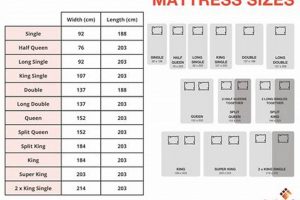
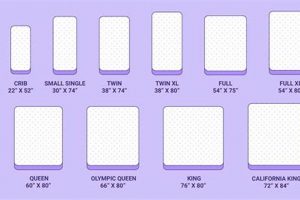
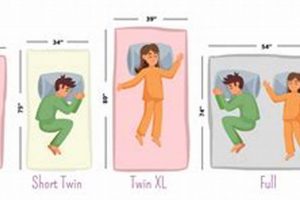
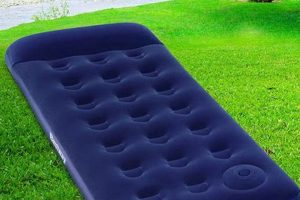
![Best Coleman Queen Size Air Mattress [Guide] Organic & Natural Mattress Buyer’s Guide: Non-Toxic Sleep Solutions Best Coleman Queen Size Air Mattress [Guide] | Organic & Natural Mattress Buyer’s Guide: Non-Toxic Sleep Solutions](https://mattressworldpa.com/wp-content/uploads/2025/07/th-2264-300x200.jpg)
